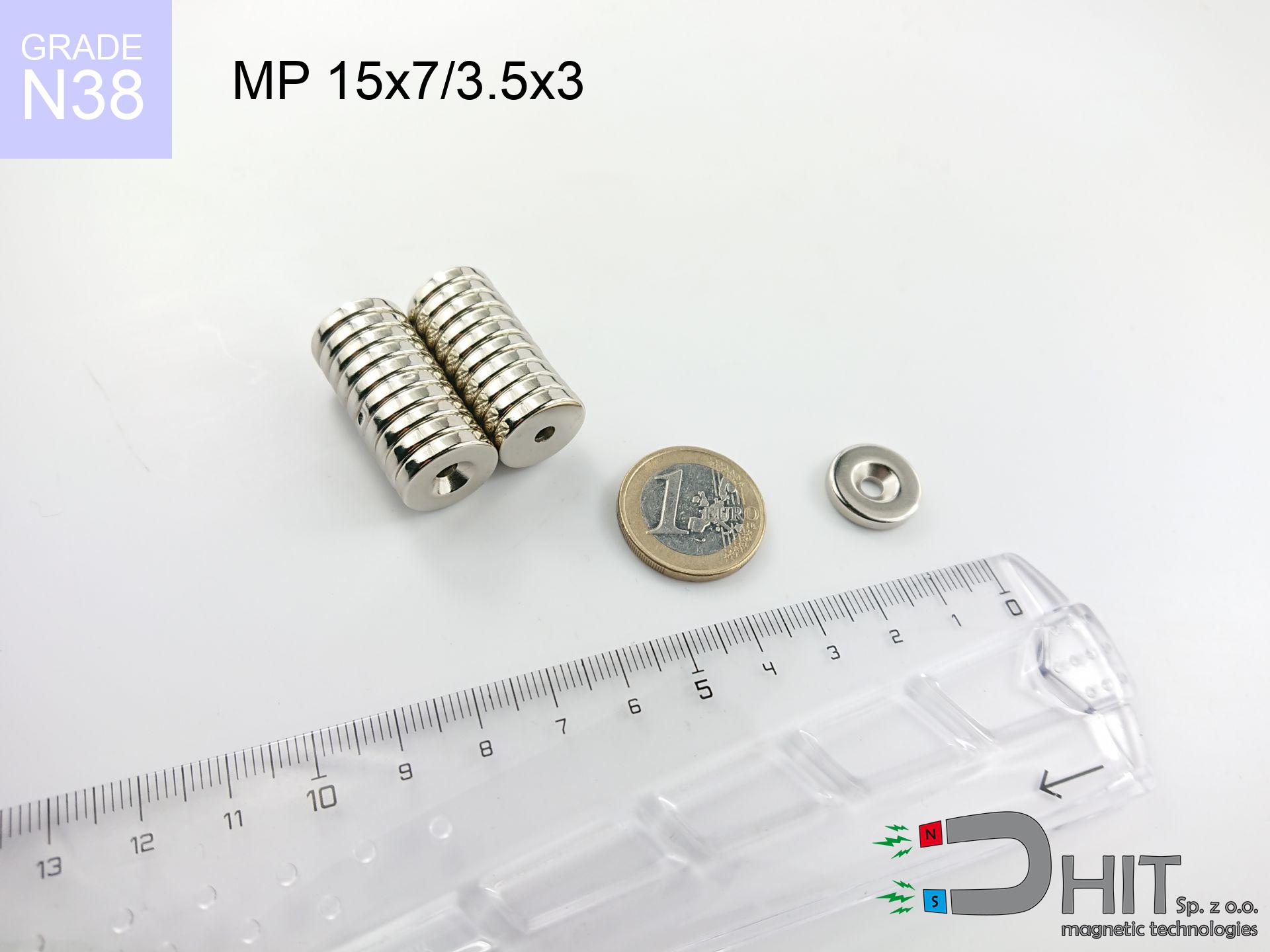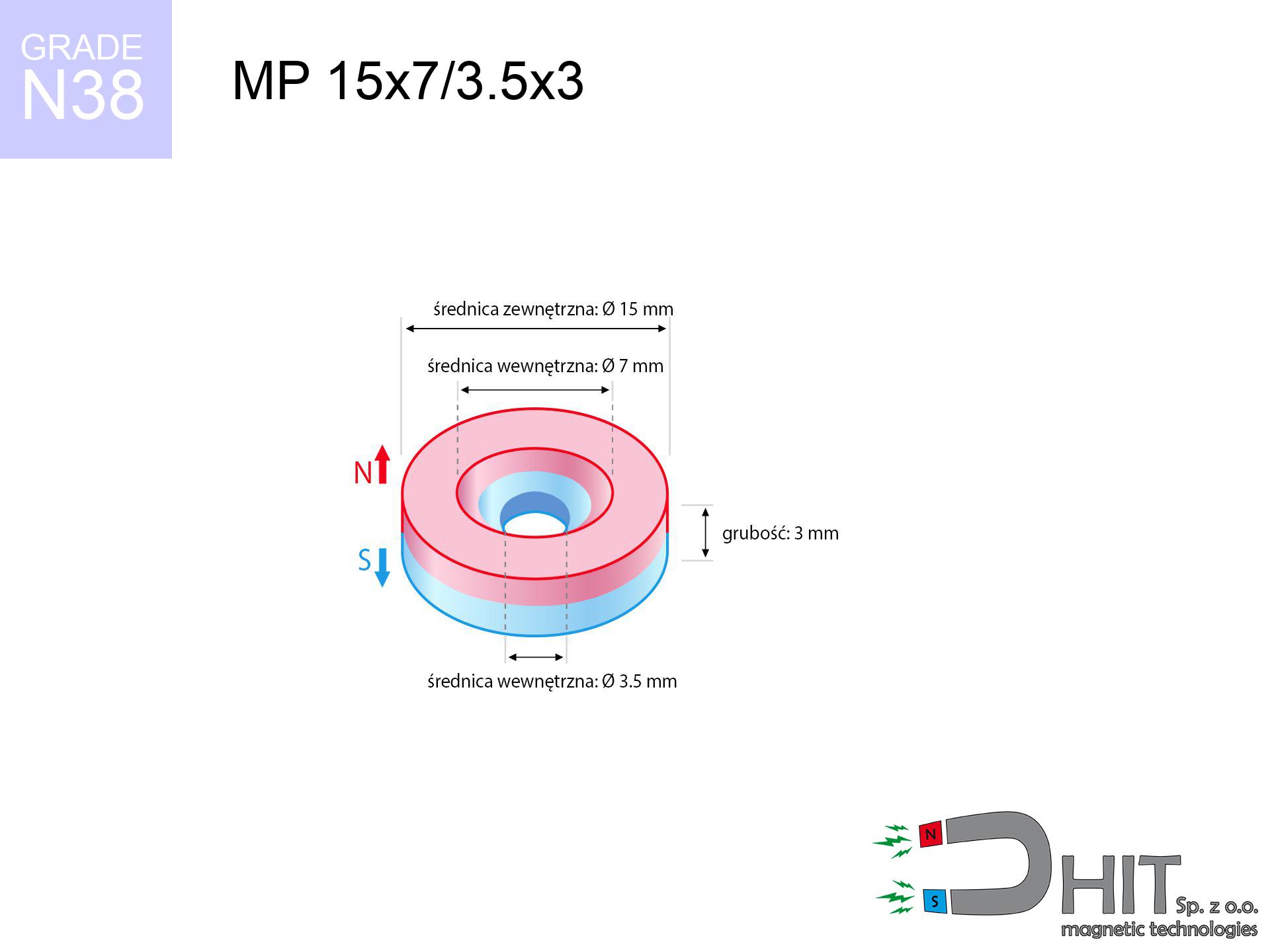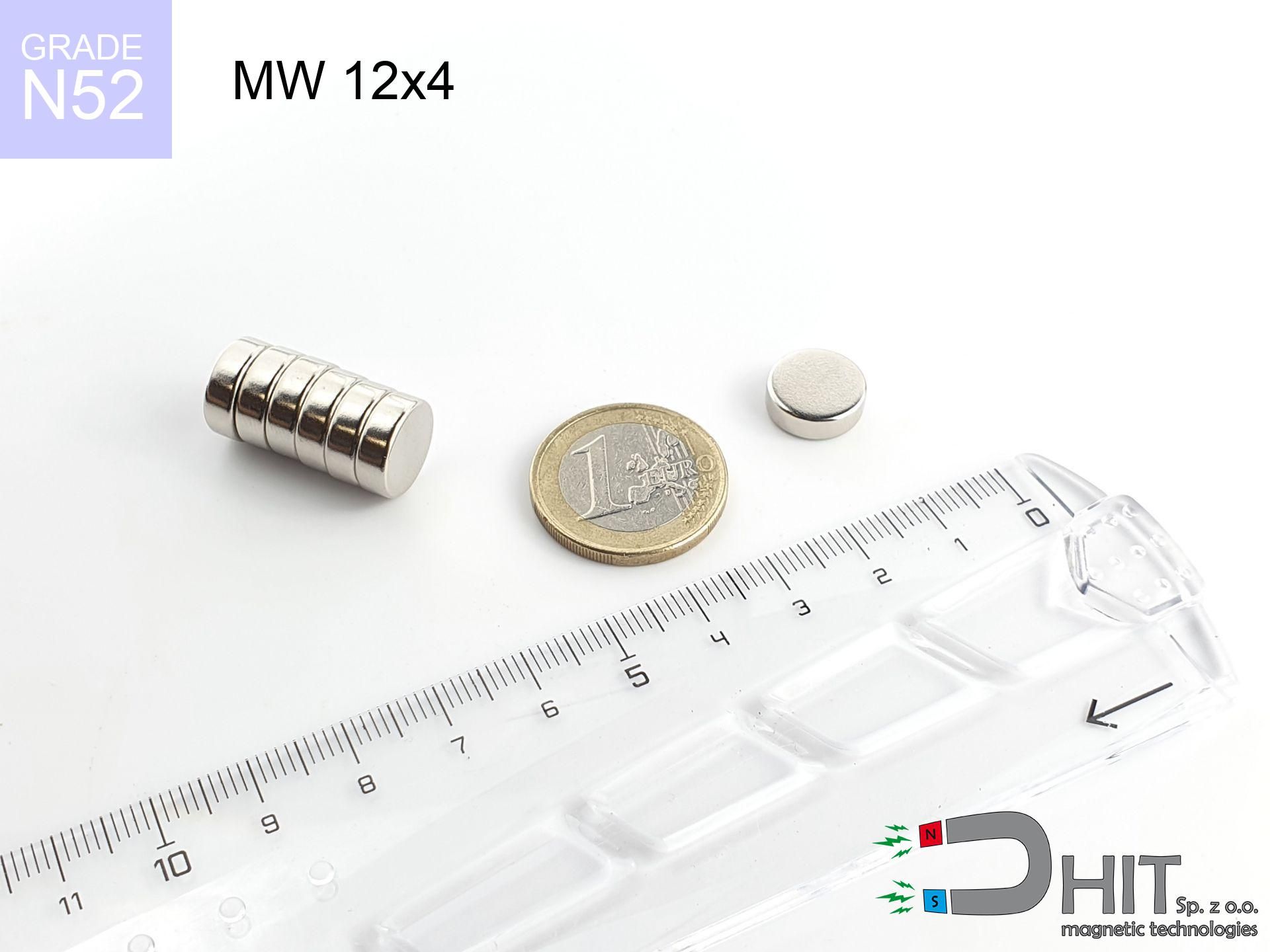MP 15x7/3.5x3 / N38 - ring magnet
ring magnet
Catalog no 030182
GTIN/EAN: 5906301811992
Diameter
15 mm [±0,1 mm]
internal diameter Ø
7/3.5 mm [±0,1 mm]
Height
3 mm [±0,1 mm]
Weight
3.76 g
Magnetization Direction
↑ axial
Load capacity
2.71 kg / 26.61 N
Magnetic Induction
230.16 mT / 2302 Gs
Coating
[NiCuNi] Nickel
1.747 ZŁ with VAT / pcs + price for transport
1.420 ZŁ net + 23% VAT / pcs
bulk discounts:
Need more?Want to negotiate?
Pick up the phone and ask
+48 888 99 98 98
or contact us through
our online form
the contact section.
Specifications and appearance of magnets can be analyzed on our
online calculation tool.
Orders submitted before 14:00 will be dispatched today!
MP 15x7/3.5x3 / N38 - ring magnet
Specification / characteristics MP 15x7/3.5x3 / N38 - ring magnet
| properties | values |
|---|---|
| Cat. no. | 030182 |
| GTIN/EAN | 5906301811992 |
| Production/Distribution | Dhit sp. z o.o. |
| Country of origin | Poland / China / Germany |
| Customs code | 85059029 |
| Diameter | 15 mm [±0,1 mm] |
| internal diameter Ø | 7/3.5 mm [±0,1 mm] |
| Height | 3 mm [±0,1 mm] |
| Weight | 3.76 g |
| Magnetization Direction | ↑ axial |
| Load capacity ~ ? | 2.71 kg / 26.61 N |
| Magnetic Induction ~ ? | 230.16 mT / 2302 Gs |
| Coating | [NiCuNi] Nickel |
| Manufacturing Tolerance | ±0.1 mm |
Magnetic properties of material N38
| properties | values | units |
|---|---|---|
| remenance Br [min. - max.] ? | 12.2-12.6 | kGs |
| remenance Br [min. - max.] ? | 1220-1260 | mT |
| coercivity bHc ? | 10.8-11.5 | kOe |
| coercivity bHc ? | 860-915 | kA/m |
| actual internal force iHc | ≥ 12 | kOe |
| actual internal force iHc | ≥ 955 | kA/m |
| energy density [min. - max.] ? | 36-38 | BH max MGOe |
| energy density [min. - max.] ? | 287-303 | BH max KJ/m |
| max. temperature ? | ≤ 80 | °C |
Physical properties of sintered neodymium magnets Nd2Fe14B at 20°C
| properties | values | units |
|---|---|---|
| Vickers hardness | ≥550 | Hv |
| Density | ≥7.4 | g/cm3 |
| Curie Temperature TC | 312 - 380 | °C |
| Curie Temperature TF | 593 - 716 | °F |
| Specific resistance | 150 | μΩ⋅cm |
| Bending strength | 250 | MPa |
| Compressive strength | 1000~1100 | MPa |
| Thermal expansion parallel (∥) to orientation (M) | (3-4) x 10-6 | °C-1 |
| Thermal expansion perpendicular (⊥) to orientation (M) | -(1-3) x 10-6 | °C-1 |
| Young's modulus | 1.7 x 104 | kg/mm² |
Physical analysis of the assembly - technical parameters
The following data constitute the direct effect of a engineering analysis. Results were calculated on models for the class Nd2Fe14B. Actual conditions might slightly differ from theoretical values. Treat these data as a reference point during assembly planning.
MP 15x7/3.5x3 / N38
| Distance (mm) | Induction (Gauss) / mT | Pull Force (kg) | Risk Status |
|---|---|---|---|
| 0 mm |
1995 Gs
199.5 mT
|
2.71 kg / 2710.0 g
26.6 N
|
warning |
| 1 mm |
1833 Gs
183.3 mT
|
2.29 kg / 2289.1 g
22.5 N
|
warning |
| 2 mm |
1618 Gs
161.8 mT
|
1.78 kg / 1784.1 g
17.5 N
|
weak grip |
| 3 mm |
1385 Gs
138.5 mT
|
1.31 kg / 1307.5 g
12.8 N
|
weak grip |
| 5 mm |
959 Gs
95.9 mT
|
0.63 kg / 627.1 g
6.2 N
|
weak grip |
| 10 mm |
362 Gs
36.2 mT
|
0.09 kg / 89.3 g
0.9 N
|
weak grip |
| 15 mm |
156 Gs
15.6 mT
|
0.02 kg / 16.5 g
0.2 N
|
weak grip |
| 20 mm |
78 Gs
7.8 mT
|
0.00 kg / 4.1 g
0.0 N
|
weak grip |
| 30 mm |
27 Gs
2.7 mT
|
0.00 kg / 0.5 g
0.0 N
|
weak grip |
| 50 mm |
6 Gs
0.6 mT
|
0.00 kg / 0.0 g
0.0 N
|
weak grip |
MP 15x7/3.5x3 / N38
| Distance (mm) | Friction coefficient | Pull Force (kg) |
|---|---|---|
| 0 mm | Stal (~0.2) |
0.54 kg / 542.0 g
5.3 N
|
| 1 mm | Stal (~0.2) |
0.46 kg / 458.0 g
4.5 N
|
| 2 mm | Stal (~0.2) |
0.36 kg / 356.0 g
3.5 N
|
| 3 mm | Stal (~0.2) |
0.26 kg / 262.0 g
2.6 N
|
| 5 mm | Stal (~0.2) |
0.13 kg / 126.0 g
1.2 N
|
| 10 mm | Stal (~0.2) |
0.02 kg / 18.0 g
0.2 N
|
| 15 mm | Stal (~0.2) |
0.00 kg / 4.0 g
0.0 N
|
| 20 mm | Stal (~0.2) |
0.00 kg / 0.0 g
0.0 N
|
| 30 mm | Stal (~0.2) |
0.00 kg / 0.0 g
0.0 N
|
| 50 mm | Stal (~0.2) |
0.00 kg / 0.0 g
0.0 N
|
MP 15x7/3.5x3 / N38
| Surface type | Friction coefficient / % Mocy | Max load (kg) |
|---|---|---|
| Raw steel |
µ = 0.3
30% Nominalnej Siły
|
0.81 kg / 813.0 g
8.0 N
|
| Painted steel (standard) |
µ = 0.2
20% Nominalnej Siły
|
0.54 kg / 542.0 g
5.3 N
|
| Oily/slippery steel |
µ = 0.1
10% Nominalnej Siły
|
0.27 kg / 271.0 g
2.7 N
|
| Magnet with anti-slip rubber |
µ = 0.5
50% Nominalnej Siły
|
1.36 kg / 1355.0 g
13.3 N
|
MP 15x7/3.5x3 / N38
| Steel thickness (mm) | % power | Real pull force (kg) |
|---|---|---|
| 0.5 mm |
|
0.27 kg / 271.0 g
2.7 N
|
| 1 mm |
|
0.68 kg / 677.5 g
6.6 N
|
| 2 mm |
|
1.36 kg / 1355.0 g
13.3 N
|
| 5 mm |
|
2.71 kg / 2710.0 g
26.6 N
|
| 10 mm |
|
2.71 kg / 2710.0 g
26.6 N
|
MP 15x7/3.5x3 / N38
| Ambient temp. (°C) | Power loss | Remaining pull | Status |
|---|---|---|---|
| 20 °C | 0.0% |
2.71 kg / 2710.0 g
26.6 N
|
OK |
| 40 °C | -2.2% |
2.65 kg / 2650.4 g
26.0 N
|
OK |
| 60 °C | -4.4% |
2.59 kg / 2590.8 g
25.4 N
|
|
| 80 °C | -6.6% |
2.53 kg / 2531.1 g
24.8 N
|
|
| 100 °C | -28.8% |
1.93 kg / 1929.5 g
18.9 N
|
MP 15x7/3.5x3 / N38
| Gap (mm) | Attraction (kg) (N-S) | Repulsion (kg) (N-N) |
|---|---|---|
| 0 mm |
3.48 kg / 3483 g
34.2 N
3 483 Gs
|
N/A |
| 1 mm |
3.24 kg / 3239 g
31.8 N
3 846 Gs
|
2.91 kg / 2915 g
28.6 N
~0 Gs
|
| 2 mm |
2.94 kg / 2942 g
28.9 N
3 666 Gs
|
2.65 kg / 2648 g
26.0 N
~0 Gs
|
| 3 mm |
2.62 kg / 2621 g
25.7 N
3 460 Gs
|
2.36 kg / 2359 g
23.1 N
~0 Gs
|
| 5 mm |
1.98 kg / 1976 g
19.4 N
3 004 Gs
|
1.78 kg / 1778 g
17.4 N
~0 Gs
|
| 10 mm |
0.81 kg / 806 g
7.9 N
1 919 Gs
|
0.73 kg / 725 g
7.1 N
~0 Gs
|
| 20 mm |
0.11 kg / 115 g
1.1 N
724 Gs
|
0.10 kg / 103 g
1.0 N
~0 Gs
|
| 50 mm |
0.00 kg / 2 g
0.0 N
88 Gs
|
0.00 kg / 0 g
0.0 N
~0 Gs
|
MP 15x7/3.5x3 / N38
| Object / Device | Limit (Gauss) / mT | Safe distance |
|---|---|---|
| Pacemaker | 5 Gs (0.5 mT) | 5.5 cm |
| Hearing aid | 10 Gs (1.0 mT) | 4.5 cm |
| Mechanical watch | 20 Gs (2.0 mT) | 3.5 cm |
| Phone / Smartphone | 40 Gs (4.0 mT) | 3.0 cm |
| Car key | 50 Gs (5.0 mT) | 2.5 cm |
| Payment card | 400 Gs (40.0 mT) | 1.0 cm |
| HDD hard drive | 600 Gs (60.0 mT) | 1.0 cm |
MP 15x7/3.5x3 / N38
| Start from (mm) | Speed (km/h) | Energy (J) | Predicted outcome |
|---|---|---|---|
| 10 mm |
27.63 km/h
(7.67 m/s)
|
0.11 J | |
| 30 mm |
46.90 km/h
(13.03 m/s)
|
0.32 J | |
| 50 mm |
60.54 km/h
(16.82 m/s)
|
0.53 J | |
| 100 mm |
85.62 km/h
(23.78 m/s)
|
1.06 J |
MP 15x7/3.5x3 / N38
| Technical parameter | Value / Description |
|---|---|
| Coating type | [NiCuNi] Nickel |
| Layer structure | Nickel - Copper - Nickel |
| Layer thickness | 10-20 µm |
| Salt spray test (SST) ? | 24 h |
| Recommended environment | Indoors only (dry) |
MP 15x7/3.5x3 / N38
| Parameter | Value | SI Unit / Description |
|---|---|---|
| Magnetic Flux | 3 461 Mx | 34.6 µWb |
| Pc Coefficient | 0.26 | Low (Flat) |
MP 15x7/3.5x3 / N38
| Environment | Effective steel pull | Effect |
|---|---|---|
| Air (land) | 2.71 kg | Standard |
| Water (riverbed) |
3.10 kg
(+0.39 kg Buoyancy gain)
|
+14.5% |
1. Wall mount (shear)
*Warning: On a vertical wall, the magnet holds just a fraction of its perpendicular strength.
2. Steel thickness impact
*Thin steel (e.g. 0.5mm PC case) significantly weakens the holding force.
3. Power loss vs temp
*For N38 grade, the critical limit is 80°C.
4. Demagnetization curve and operating point (B-H)
chart generated for the permeance coefficient Pc (Permeance Coefficient) = 0.26
This simulation demonstrates the magnetic stability of the selected magnet under specific geometric conditions. The solid red line represents the demagnetization curve (material potential), while the dashed blue line is the load line based on the magnet's geometry. The Pc (Permeance Coefficient), also known as the load line slope, is a dimensionless value that describes the relationship between the magnet's shape and its magnetic stability. The intersection of these two lines (the black dot) is the operating point — it determines the actual magnetic flux density generated by the magnet in this specific configuration. A higher Pc value means the magnet is more 'slender' (tall relative to its area), resulting in a higher operating point and better resistance to irreversible demagnetization caused by external fields or temperature. A value of 0.42 is relatively low (typical for flat magnets), meaning the operating point is closer to the 'knee' of the curve — caution is advised when operating at temperatures near the maximum limit to avoid strength loss.
Elemental analysis
| iron (Fe) | 64% – 68% |
| neodymium (Nd) | 29% – 32% |
| boron (B) | 1.1% – 1.2% |
| dysprosium (Dy) | 0.5% – 2.0% |
| coating (Ni-Cu-Ni) | < 0.05% |
Environmental data
| recyclability (EoL) | 100% |
| recycled raw materials | ~10% (pre-cons) |
| carbon footprint | low / zredukowany |
| waste code (EWC) | 16 02 16 |
See more proposals
Pros and cons of neodymium magnets.
Pros
- They virtually do not lose power, because even after 10 years the decline in efficiency is only ~1% (based on calculations),
- They retain their magnetic properties even under external field action,
- A magnet with a metallic nickel surface has better aesthetics,
- The surface of neodymium magnets generates a maximum magnetic field – this is a distinguishing feature,
- Due to their durability and thermal resistance, neodymium magnets can operate (depending on the shape) even at high temperatures reaching 230°C or more...
- Possibility of accurate machining as well as adjusting to atypical conditions,
- Versatile presence in high-tech industry – they are used in magnetic memories, brushless drives, precision medical tools, also multitasking production systems.
- Thanks to their power density, small magnets offer high operating force, in miniature format,
Weaknesses
- To avoid cracks upon strong impacts, we recommend using special steel housings. Such a solution protects the magnet and simultaneously increases its durability.
- NdFeB magnets lose force when exposed to high temperatures. After reaching 80°C, many of them experience permanent weakening of strength (a factor is the shape as well as dimensions of the magnet). We offer magnets specially adapted to work at temperatures up to 230°C marked [AH], which are extremely resistant to heat
- Magnets exposed to a humid environment can corrode. Therefore while using outdoors, we suggest using water-impermeable magnets made of rubber, plastic or other material protecting against moisture
- Due to limitations in creating threads and complex shapes in magnets, we recommend using casing - magnetic mount.
- Health risk to health – tiny shards of magnets can be dangerous, if swallowed, which gains importance in the aspect of protecting the youngest. It is also worth noting that tiny parts of these products are able to disrupt the diagnostic process medical after entering the body.
- Higher cost of purchase is a significant factor to consider compared to ceramic magnets, especially in budget applications
Lifting parameters
Maximum lifting capacity of the magnet – what affects it?
- on a base made of mild steel, effectively closing the magnetic flux
- possessing a massiveness of minimum 10 mm to ensure full flux closure
- with an ground contact surface
- under conditions of ideal adhesion (surface-to-surface)
- for force applied at a right angle (in the magnet axis)
- in stable room temperature
Practical lifting capacity: influencing factors
- Space between magnet and steel – even a fraction of a millimeter of distance (caused e.g. by veneer or unevenness) significantly weakens the pulling force, often by half at just 0.5 mm.
- Direction of force – maximum parameter is reached only during pulling at a 90° angle. The shear force of the magnet along the surface is usually several times lower (approx. 1/5 of the lifting capacity).
- Metal thickness – the thinner the sheet, the weaker the hold. Magnetic flux penetrates through instead of converting into lifting capacity.
- Metal type – different alloys attracts identically. Alloy additives worsen the interaction with the magnet.
- Surface finish – full contact is possible only on polished steel. Rough texture reduce the real contact area, reducing force.
- Heat – NdFeB sinters have a sensitivity to temperature. When it is hot they lose power, and in frost gain strength (up to a certain limit).
Lifting capacity testing was conducted on a smooth plate of suitable thickness, under a perpendicular pulling force, however under shearing force the holding force is lower. Moreover, even a minimal clearance between the magnet’s surface and the plate lowers the load capacity.
Operating temperature
Regular neodymium magnets (N-type) lose power when the temperature exceeds 80°C. This process is irreversible.
Allergy Warning
Warning for allergy sufferers: The nickel-copper-nickel coating contains nickel. If redness happens, immediately stop working with magnets and use protective gear.
This is not a toy
Adult use only. Tiny parts pose a choking risk, leading to serious injuries. Keep out of reach of children and animals.
Pacemakers
For implant holders: Powerful magnets affect medical devices. Keep minimum 30 cm distance or request help to work with the magnets.
Threat to navigation
Note: rare earth magnets produce a field that disrupts precision electronics. Keep a separation from your phone, tablet, and navigation systems.
Shattering risk
NdFeB magnets are ceramic materials, which means they are prone to chipping. Impact of two magnets leads to them shattering into shards.
Pinching danger
Protect your hands. Two large magnets will snap together immediately with a force of several hundred kilograms, destroying everything in their path. Exercise extreme caution!
Powerful field
Exercise caution. Neodymium magnets attract from a distance and connect with huge force, often quicker than you can react.
Threat to electronics
Powerful magnetic fields can corrupt files on payment cards, hard drives, and storage devices. Keep a distance of at least 10 cm.
Fire warning
Mechanical processing of NdFeB material carries a risk of fire hazard. Magnetic powder oxidizes rapidly with oxygen and is difficult to extinguish.




![SM 25x175 [2xM8] / N42 - magnetic separator SM 25x175 [2xM8] / N42 - magnetic separator](https://cdn3.dhit.pl/graphics/products/sm-25x175-2xm8-fux.jpg)
![SM 32x300 [2xM8] / N42 - magnetic separator SM 32x300 [2xM8] / N42 - magnetic separator](https://cdn3.dhit.pl/graphics/products/sm-32x300-2xm8-pel.jpg)

![UMGW 16x13x5 [M4] GW / N38 - magnetic holder internal thread UMGW 16x13x5 [M4] GW / N38 - magnetic holder internal thread](https://cdn3.dhit.pl/graphics/products/um-16x13x5-m4-gw-fig.jpg)

